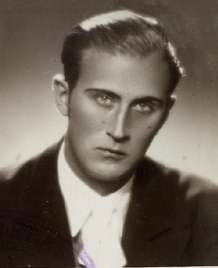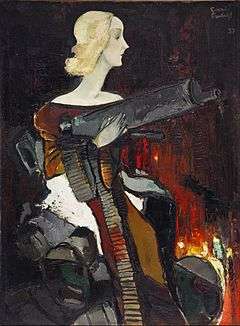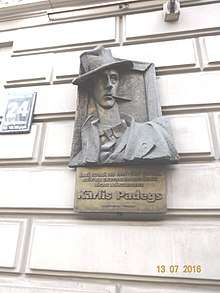Kārlis Padegs
Kārlis Padegs (8 October 1911 – 19 April 1940) is one of Latvia's most popular artists. He studied under noted Latvian painter Vilhelms Purvītis at the Latvia Art Academy. Padegs' style was original and shocking – using themes which were very iconoclastic at the time.
Kārlis Padegs | |
|---|---|
 | |
| Born | 8 October 1911 |
| Died | 19 April 1940 (aged 28) |
| Nationality | Latvian |
| Known for | art |
| Movement | Expressionism |
Padegs personality
Kārlis Padegs was born on 8 October 1911 in Torņakalns, workers district of Riga. Padegs spent all his life in Riga with the exception of several years in childhood during World War I when he lived in Dorpat (Tartu) Estonia. The presence of his motherland is, however, rarely felt in his art. One is made acutely aware of an atmosphere reminiscent of Chicago and Paris.
Kārlis Padegs turned into a legend of Riga's artistic life. He was contemporary of the tempestuous Jānis Tīdemanis (Džonis) who spent his formative years in Belgium and the barefooted tramp Irbīte (pastel painter Voldemārs Irbe). Some Riga inhabitants will still recall Kārlis Padegs as a most extravagant personality- his Spanish hat, a red scarf, a long black coat, pig-skin gloves, a bamboo cane, patent leather shoes and a white gaiters with little black buttons. The artist may be better remembered than his exhibitions held in quite untraditional premises (at cafe, in the street, in dancing halls) or in the show-windows of L.Kreicberga's photo salon that once even attracted the attention of the police. On November 26, 1938 Kārlis Padegs marries Elvira Feodorovich.
Padegs was a Riga dandy whose doings were described in newspapers and discussed in society and who obtrusively played up to the public before exhibitions.
He once wrote in the newspaper that just this outsider who dreams about Narcissus and the perverse madonna does not forget the invalid. He shows him side by side with the fashionable Dorian Gray, the lover Don Juan, but why?- Because of sharp contrast, to make even the most dim-minded people understand that the world in World War I has already lost 12,996,117 people killed and 5,669,000 disabled people who have not died yet, and we do not want new victims. [1]
Padegs art
The art of Kārlis Padegs is essentially original. His works viewed at exhibitions in the mid-1930s did not seem to his contemporaries typical and symptomatic of Latvian art. They tried to trace the more likely sources of his outside influences- the Old Dutch masters, the Belgian Félicien Rops, the Frenchman Henri de Toulouse-Lautrec and Henri Matisse, the Norwegian painter Edvard Munch and many more. In most cases the comparison was not too favourable. On the other hand, Kārlis Padegs ranking among this illustrious galaxy of artists including many outstanding figures in art was most honourable and alluring.
 My Babe from the Street (1930).
My Babe from the Street (1930). Self-portrait (1932).
Self-portrait (1932). Mr. Padegs and the Astral (1939).
Mr. Padegs and the Astral (1939). Five o'clock in the morgue (1935)
Five o'clock in the morgue (1935) Cabaret (1935)
Cabaret (1935) Funeral of the unknown soldiers (1939)
Funeral of the unknown soldiers (1939)
Since the exhibition mounted in 1933 Kārlis Padegs art became an expression of unpleasant, even ugly traits opposed to the tendency towards beauty in Latvian art. Padegs once said: "I must often listen to reproaches- why do you draw such disgusting pictures when there is so much beauty in the world?- But there are also many abominable things and somebody must draw them too, I answer. I want to show the seamy side of life which we do not like to see in order not to spoil our feeling of comfort or our good appetite".[2]
Padegs deliberately strove to shock the morality of his contemporaries (as did avant-garde artists), to bewilder the upper and middle class by the squalid tragedy of the streets. His art was turned towards the derelicts of society- the city's poor, prostitutes, drunkards, cripples, debauches. He developed a kind of highly erotic traits, showed the seclusion of these people. His main contribution to this effect was The book for poor people representing with complete honesty urban life scenes.
Even the female nude in Kārlis Padegs paintings and drawings has nothing in common with attainable or worshipped beauty. Beauty is expressed in terms of exotic ever-refinement. His women's images incorporate sensual exposure of a prostitutes body and the divine mystery of a madonna.

Padegs art came to full flower in a society of high development in art and thought. You will not find in his works traits of amazement. He was an artist with a strong ironical bent willing to combine hardly comparable things and by this method he achieved exceedingly sharp effects. In 1932 he painted his famous Madonna with a Machine-gun, a picture of a recognizable type as a foreboding of World War II. Padegs mind was absorbed with unconventional themes. Death was one of the most unpleasant subjects for the artist who suffered from tuberculosis for many years.
In Latvian art Padegs stood apart as he did in everyday life. Defiant and rousing envy. His life was full of paradoxes. He had made his mark as a perfect Latvian draftsman when he took a new direction and graduated from the landscape studio at the Latvian Academy of arts thanks to the help of rector Vilhelms Purvītis, a landscapist of European fame in the early 20th. century.
Padegs preferred themes were modern urban life, antiwar subjects, an idealised dream world and sarcastic self-portraits. His work was redolent with expressive distortion, refined features and sharp contrasts.
Padegs death and legacy

Kārlis Padegs died in Riga, April 1940 from tuberculosis. He was 28 years old. He suffered from it all his life and after the very productive period in the 1939 he was so exhausted that his illness finally overcame the young painter.
In later days he was nearly forgotten and only in the early 1980s marking the end of a period of general self- complacence did one of the most peculiar Latvian artists and his work became of current interest.
Over this period a great many pieces of Padeg's heritage (mostly his earlier works) were lost. Some of them may in all probability be regained.
He lived at Elizabete iela 24, where there is a plaque to his memory.
External links
| Wikimedia Commons has media related to Kārlis Padegs. |
References
- Jānis Kalnačs. Kārlis Padegs Rīga. 1993.
- Jānis Kalnačs. Kārlis Padegs Rīga. 1993